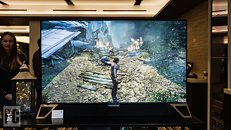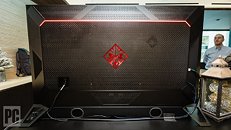
Samsung Electronics Takes Gaming Experiences To The Next Level With Global Launch of Odyssey Ark
Samsung Electronics today announced the global launch of Odyssey Ark, the world's first 55-inch 1000R curved gaming screen, adding a completely new form factor to the industry-leading Odyssey lineup. The huge display delivers a 165 Hz refresh rate, 1 ms response time (GtG), plus an all new Cockpit Mode and an exclusive controller, the Ark Dial—offering the ultimate window into the world of gaming with unparalleled immersion.
"We are excited to unveil this totally unique, next-generation gaming screen, the Odyssey Ark. This 55-inch 1000R curved gaming screen brings together premium, cinematic picture quality, immersive surround sound and an incredibly flexible interface which gamers increasingly demand," said Hyesung Ha, Executive Vice President of Visual Display Business at Samsung Electronics. "The gaming community craves new experiences and Odyssey Ark delivers access to a new world of gaming that will raise standards across the entire industry." The groundbreaking Odyssey Ark is built to deliver incredible cinematic experiences, superior gaming performance and an interface that offers completely optimized flexibility. Originally unveiled at the Consumer Electronics Show earlier this year, the Odyssey Ark was recognized as a CES Innovation Award Honoree.
"We are excited to unveil this totally unique, next-generation gaming screen, the Odyssey Ark. This 55-inch 1000R curved gaming screen brings together premium, cinematic picture quality, immersive surround sound and an incredibly flexible interface which gamers increasingly demand," said Hyesung Ha, Executive Vice President of Visual Display Business at Samsung Electronics. "The gaming community craves new experiences and Odyssey Ark delivers access to a new world of gaming that will raise standards across the entire industry." The groundbreaking Odyssey Ark is built to deliver incredible cinematic experiences, superior gaming performance and an interface that offers completely optimized flexibility. Originally unveiled at the Consumer Electronics Show earlier this year, the Odyssey Ark was recognized as a CES Innovation Award Honoree.























































